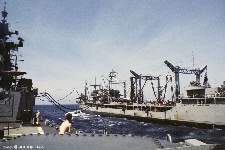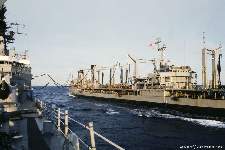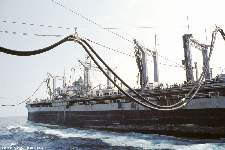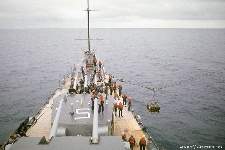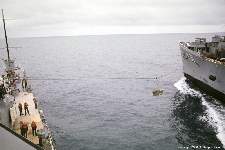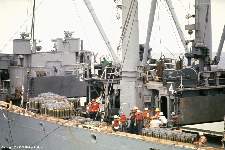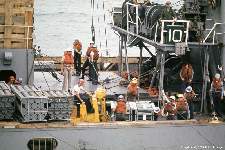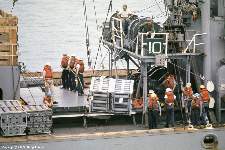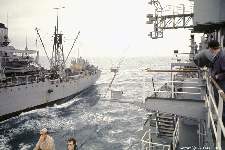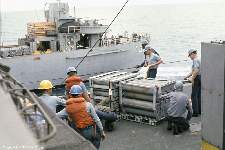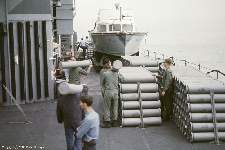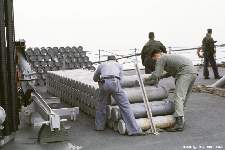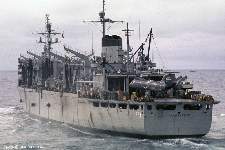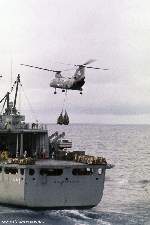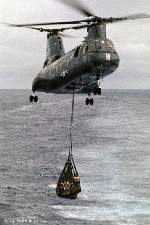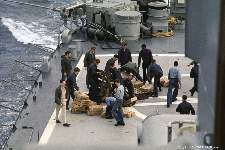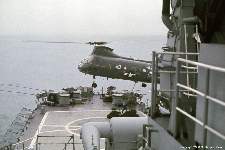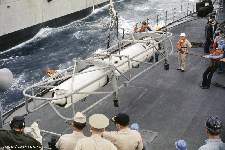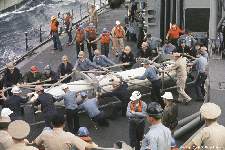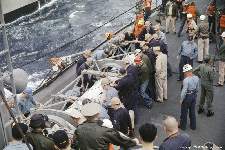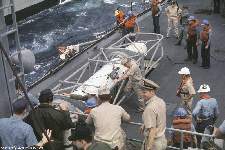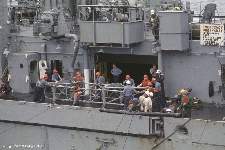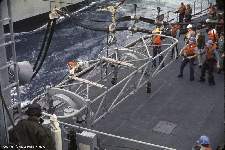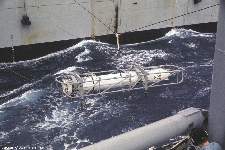Underway replenishment (UNREPS), the transfer of fuel, ammunition, food and other supplies between ships at sea, was the key factor that allowed the United States Navy to operate across the vast expanses of the Pacific Ocean during World War Two. With combat operations advancing rapidly and no supply bases near the areas of operations the Navy had to develop effective means of keeping the fleet supplied at sea.
Entire task forces consisting of dozens of ships would resupply while steaming toward an operations area. Convoys of replenishment ships would rendezvous with the fleet, and individual supply ships would take stations within the moving fleet. The combat ships and transports would take turns moving from their assigned positions in the formation to go alongside the oilers, cargo ships and ammunition ships to replenish stores, then they would return to station and another ship would go alongside the supply ship. When resupplying was finished the supply convoy would reform and return to a supply base far in the rear of the ongoing action.
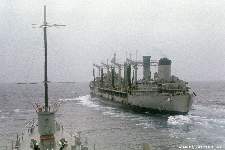
UNREPS continues to be important to the operations of the U. S. Navy, allowing it to operate anywhere on the oceans of Earth. Here are some photos that show how it was done in the 1970s.
The supply ship, here the fleet oiler USS Passumpsic AO-107, maintained a steady course and speed. The Oklahoma City came up along the oiler's port side and slowed to match its speed, maneuvering to reduce the distance between the ships to about 80 feet, give or take 20 feet. An experienced skipper like Captain Howell made the maneuver look easy, like driving a car into a garage. However, it was a 15,000 ton car, and the garage was moving.
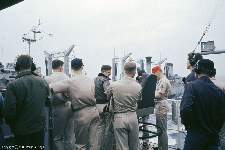
This is the open bridge of the Okie Boat while we were alongside the Passumpsic. This is where the action was. The fellow in the leather jacket without a cap is Captain Howell. The Marine orderly in the red cap was probably delivering a message just received. To the left of the Captain is the Officer of the Deck (OOD - dark hair without a cap) who was actually driving the ship. He watched the position of the Okie Boat relative to the oiler, both fore and aft and distance, and gave orders for slight adjustments to course and speed to maintain a steady position with respect to the oiler. This was the most critical part of the operation, and definitely the most fun! Inside the pilot house the helmsman controlled the rudder to steer the ship and the lee helmsman controlled the engine order telegraph to send propeller speed instructions to the engine rooms. Behind the OOD was the Junior Officer of the Deck (JOOD), a junior officer learning how to drive the ship. Several fellows were wearing sound powered phone headsets. One talked to the men at the helm and lee helm to pass steering and engine speed orders from the OOD. The others were in communication with the crews handling the transfer rigging and fueling hoses.
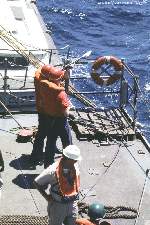

When the Okie Boat was on station alongside we fired a shot line across the gap between ships. It was a light weight line with a lighted buoy on the end (so it could be seen at night). It was fired from a shot line gun. The crew on the oiler connected a heavier line to the shot line and men on the Oklahoma City pulled it over by hand. A still heavier line was attached to it, and so on, until the heavy transfer rigging cables were pulled across the gap between the ships. These cables were attached to the Okie Boat with quick releasing pelican hooks. If the ships should suddenly have to maneuver the hooks were released and the transfer gear was dropped into the ocean for the replenishment ship to recover. This was something you really didn't want to do. However, on one occasion during rearming a sailor went over the side. The ships immediately executed an emergency breakaway and the man was back aboard the Okie Boat in less than 12 minutes.
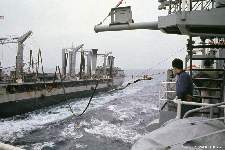
When the transfer rigging was in place between the ships, the Passumpsic sent over the hoses and we started taking on fuel. If you look closely you will see a small yellow flag on a line running between the ships. A seaman on the Okie Boat pulled on this line to keep it taut during the maneuver. This was the distance line that the OOD used to measure the distance between the two ships. It had different colored flags at 20 foot intervals. The desired station keeping distance between ships varied from 80 to 120 feet, closer for smaller supply ships and greater with larger ships. The OOD tried to keep the correct color flag right at the railing on the Okie Boat. This took quite a bit of skill, especially in high winds and heavy seas. Underway refueling operations typically took about an hour and a half to complete, from approach to breakaway.

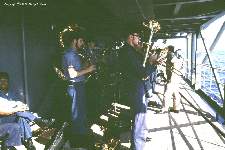
The refueling hose had a plug that mated with the receptacle shown here. When it was securely in place the crew on the oiler started pumping. Then, while everyone waited for the transfer to finish the Seventh Fleet band played to help relieve the monotony. When the transfer was complete the oiler pulled in the hoses, then we released the cables and steamed away.
We normally took the supply ship down our starboard side, but we could resupply from the port side also. Notice the difference in freeboard between the oilers in these three photos. The ship on the left was full of oil and riding pretty low in the water. The ship in the picture to the right was running high and dry.
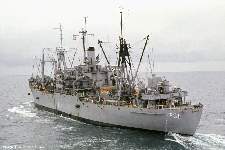
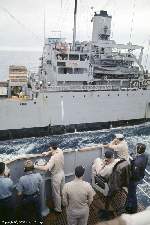
Ammunition transfers were accomplished pretty much like refueling, but instead of hoses it was pallets of shells and powder that crossed the transfer rigging. Here we were pulling alongside the USS Chara AE-31. Her decks were loaded with pallets of 5 inch and 6 inch projectiles and powder cans. Again, she held her course and speed while we maneuvered alongside.
Captain Howell (in the chair) talked by phone to the Captain of the Chara. The OOD was the fellow standing beside the pelorus (gyro compass indicator). The sound talkers were in communication with the pilot house and the rearming detail.
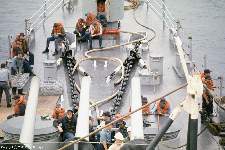
On our fo'c'sl the rearming detail had laid out charged fire hoses and rigged the transfer lines. The rigging passed over a tripod that was raised on top of the six inch gun turret with the cable anchored to the main deck on the port side. Plywood sheets were laid out to protect our nice teak deck. Everyone wore life jackets because even a slight mishap could send a man over the side.
Pallets of six inch projectiles started rolling over on a trolley that rode on the transfer cable. The Chara's crew operated winches to control movement, while a man on the Okie Boat gave signals with colored paddles. With this visual coordination between the winch operator on the Chara and the man on the Okie Boat directing the operation the procedure went very smoothly.
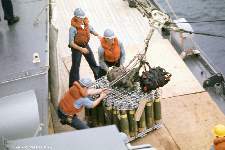
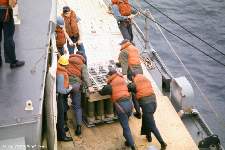
The pallets were wrestled to a stop as the cables were slackened. Then a hand operated lift, assisted by a shove, was used to move the pallet to the opposite side of the ship. Meanwhile, back aft the Chara was sending over pallets of powder cans. Both ships' crews were pretty busy for a while. Ammunition transfers usually took an hour and forty five minutes to two hours.
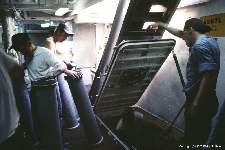
After the pallets were aboard they were broken down and each projectile and powder can was hand carried to the magazines forward below the turret. Projectiles were loaded forward because they were heavier. The lighter powder cans were loaded aft because they were easier to carry the long distance forward on rolling decks. Each projectile and powder can was transferred down five deck levels to the magazines. Here the crew use slides rigged on the ladders to move the six inch powder cans.
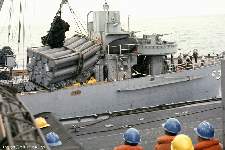
During UNREPS we also sent back empty powder cans. After gunfire missions we would save as many of the brass shell cases as we could recover (some might go over the side) and pack them in the same powder cans that we received them in. Prior to UNREPS the cans containing the spent powder cases were stacked on the missile house. After we received a new load of ammunition we sent the empties back to the ammunition ship. At least, most of them went back. Some became souvenirs - ash trays made from the bases of the six inch powder cases were very popular. In Hong Kong a pile of brass cases would purchase a paint job for the hull by local entrepreneurs.
The most interesting UNREPS happened when we went alongside the huge fleet supply ships like the USS Sacramento AOE-1. The "Sack-o-potatoes" was about 200 feet longer than the Okie Boat, and we could receive fuel, ammunition, supplies and missiles from her. It made for a busy day. Even before we were alongside her helo began transferring nets full of stores to our fantail. This was called "VERTREPS." There the goods were manhandled below deck to stowage lockers. While this was going on we were sending back empty nets via helo on the fantail. The helo pad was pretty small compared to the size of the helo and its rotor blades. There wasn't a lot of room for the man to work who had to hook the nets onto the helo.
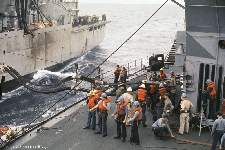
While the ship was refueling the crew prepared to transfer missiles atop the missile house. Missile transfer commenced when refueling was complete.

The "birds" were carried in protective frames called "grasshoppers." These had wheels that allowed them to be rolled into position over the strikedown hatches in the deck over the missile stowage magazine. The Sacramento crew operated the winches to control the transfer between ships. When in position over the missile house a man on the Okie Boat signaled to lower the grasshopper to the deck.
Once the grasshopper was aboard the GM Division crew pushed it into position over the hatch. When in place the wheels were locked and the hatch opened, swinging down into the missile magazine. An elevator came up to receive the missile. Then it was necessary to fiddle with things a bit to get the missile aligned with the cradle on the elevator. The grasshopper could be repositioned and the cradle on the elevator moved to mate with the missile. Then the missile was released from the grasshopper and the elevator lowered carrying the missile into the magazine. The procedure was pretty simple, but it became more complicated when the ship was rolling. The missile weighed about 3000 pounds.
It sometimes took a little extra effort to get things to fit together correctly. The fellow providing the extra kick to get things going is Chief Warrent Officer Dave Zinn. They said he had been in so long he left a trail of salt where he walked. The Warrant Officers were the people who really kept things going. Zinn was one of the Navy's authorities on the Talos missile system, and we were fortunate to have him on board. This was especially true for the new guys in town like me who had a lot of learning to do.
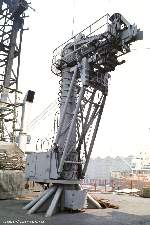
You may notice in some of the photos that an armed Marine guard is present. The missile magazine was a nuclear weapons space, and only people authorized by the Captain were permitted access to these spaces. The Marine was present to see that this rule was obeyed. His gun was loaded, and his orders were to stop anyone not wearing a photo ID badge from entering the space.
The Talos system was supposed to have a much more elaborate automatic method to transfer missiles. We carried a special FAST (Fleet Automatic Shuttle Transfer System) crane and kingpost on top of the missile house between the strikedown hatches. This piece of equipment was designed to receive the missiles as they came on board and then lower them precisely over the strikedown elevator - with no manhandling or extra kicks needed to put them in the correct position. Unfortunately, the thing never really worked correctly. Its elaborate hydraulic and electrical systems were exposed to the weather and salt spray so it was very difficult to maintain. The mechanism was removed from the Okie Boat in mid 1971, leaving the kingpost for use with ordinary highline transfers.
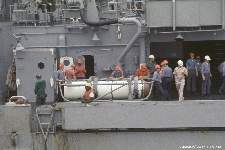
We also occasionally sent a missile back for service. The procedure was just the reverse of bringing one aboard. The Sacramento sent over an empty grasshopper and we sent it back loaded.
We transferred the missile boosters using the same procedure. These were packed with 4000 pounds of class B explosives, so they received gentle handling. They were carried in a special grasshopper designed just for the boosters. Here you can see one on the Sacramento waiting to transfer to the Oklahoma City.
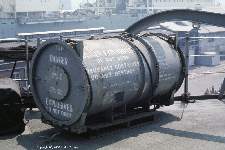
Talos warheads could be transferred independent of the missile. When warheads were shipped they traveled in a special warhead container. Nuclear warheads were always transferred in the can, and never mated to a missile. For security reasons there were no markings on the can to indicate if the enclosed warhead was conventional or nuclear.


